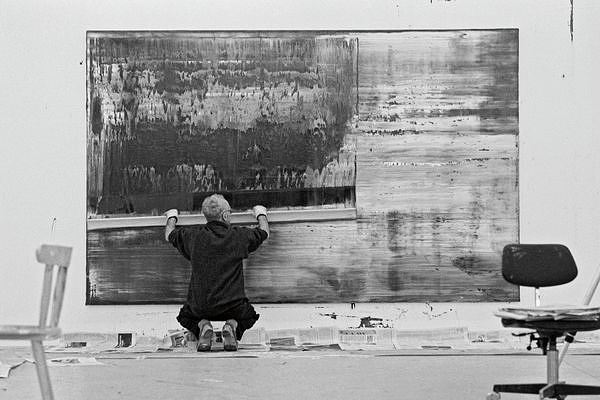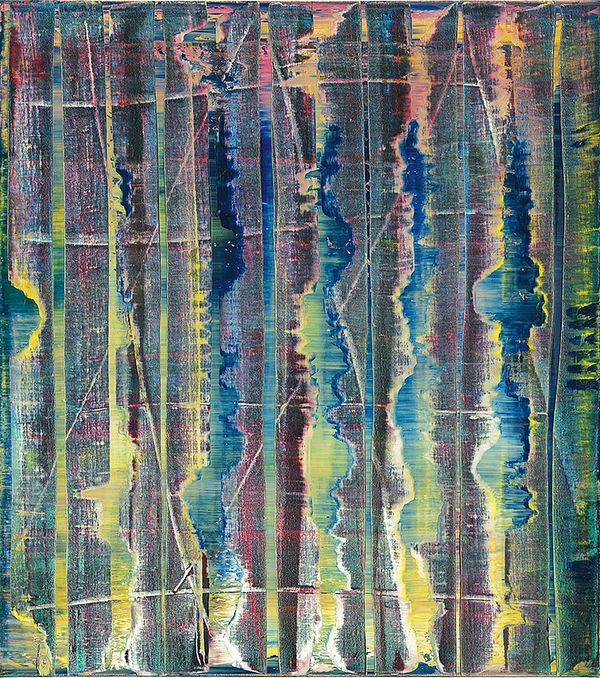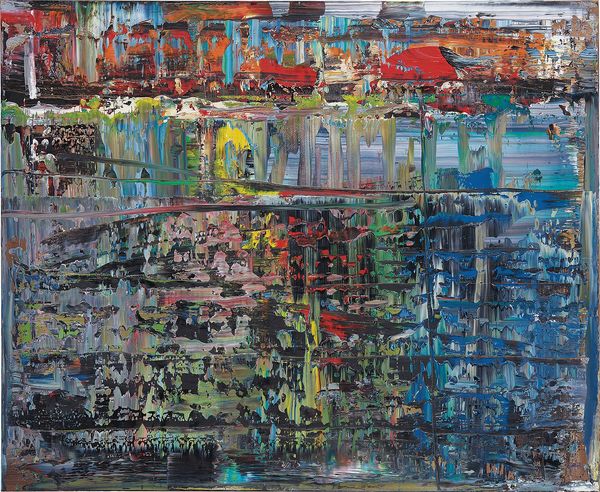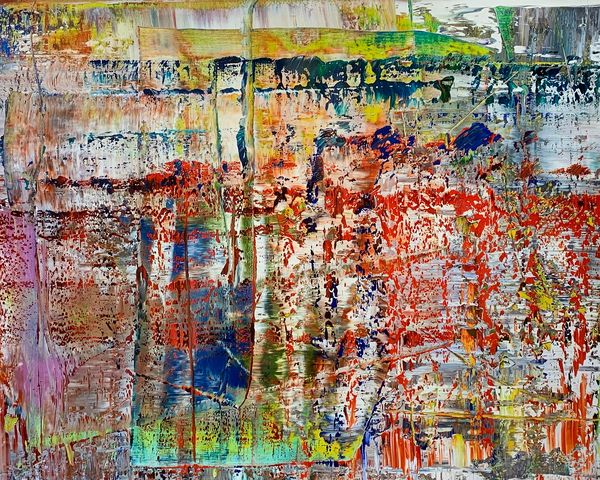Gerhard Richter Abstraktes Bild (P1), 1990/2014.
Abstraktes Bild is one of Gerhard Richter's most highly celebrated abstract cycles, realized during a climactic moment in his career as the artist achieved unprecedented critical acclaim. His reputation as one of the most influential living artists was cemented in a series of major exhibitions held during the period: first with a 1991 breakthrough retrospective at Tate Gallery, London, then his inclusion in documenta IX the following year, and in 1993, a large-scale, traveling survey of his career, Gerhard Richter: Malerei 1962-1993.

Gerhard Richter in his studio.
Richter's Abstraktes Bild series celebrates his mastery of the squeegee technique, widely considered one of his greatest contributions to art history. This process is not one of addition, but rather of subtraction — exploring the instantaneous moment of creation, purposely uncontrollable and purely facilitating the application of paint rather than the final composition. The resulting bands and smears of vibrant color rupture as they sprawl across the canvas.
[My paintings] should by all means be smarter than me… They have to be something that I no longer understand entirely. —Gerhard Richter
Around 1978, Richter began to apply paint in his abstract pictures by scraping. Typically starting with simple smears of paint or a geometric composition, Richter typically applies pressure using homemade wood and plexiglass squeegees to drag and wipe the paint repeatedly across his canvas, methodically building up and deconstructing the layers. Manipulating the viscosity of the oil medium, Richter applies thin layers of paint such that small tears in the film create spontaneous windows into underlying layers, gathering in clusters or at other times rippling across the canvas to create compositional accents or axes.

Gerhard Richter Abstraktes Bild 776-1, 1992.
Executed in 1992 following a breakthrough retrospective at London's Tate Modern the previous year, Abstraktes Bild 776-1 exemplifies the purest articulation of Richter's finest period of abstraction. In addition to the superimposed layers of rich bejewelled tones, Richter's left-to-right, stop-and-go motions of the squeegee stimulate the viewer's tactile senses by producing build-ups of paint, lining and rising above the hypnotic and aqueous columns like tides, giving form to yet another dimension of the work.

Gerhard Richter Abstraktes Bild (714-1), 1990.
A brilliant spectrum of color in Abstraktes Bild (714-1) emerges from darkness — flashes of red, yellow, blue and green burst forth like molten lava erupting from inky depths. Executed in a rich, brilliant palette of emerald, yellow and crimson, Abstraktes Bild (801-3) epitomizes Richter’s adroitness from the apex of his engagement with abstraction. Painted in 1994, the work exemplifies the artist’s mastery of his trademark squeegee method in his mature abstracts, resulting in discrete layers juxtaposed with thick, alloyed buildups of paint around the edges of the composition.
All that I am trying to do in each picture is to bring together the most disparate and mutually contradictory elements, alive and viable, in the greatest possible freedom. —Gerhard Richter
The sense of ease and spontaneity that radiates from these paintings belies Richter's famously laborious and complex working method. Indeed, it would have undergone multiple variations whereby Richter would repeatedly apply, erase, remake and obliterate the various paint strata — each addition and effacement introducing new chromatic and textural juxtapositions. Richter's process has been likened to that of a pendulum, swinging between phases of chance and control until the desired composition is achieved.

Gerhard Richter Abstraktes Bild (801-3), 1994 (detail).
Each work of his Abstraktes Bild series hints at an internal truth existing on the canvas, which is then obscured by the myriad layers that rest atop it, alluding to his own endeavors to use paint as a truth-telling device, though it always ends up actually concealing what is meant to be represented. Richter acknowledges the irrepressible human urge to construct meaning and then deliberately frustrates this search as expressed by the squeegee, whose perforations induce the sensation of a long-lost figurative reality drifting just beyond the painting's tangible surface. Though the artist was uninterested in total randomness, Richter explained of all his paintings in 1990, "they should by all means, be smarter than me. I no longer have to be able to follow them completely. They have to be something that I no longer understand entirely. As long as I comprehend them theoretically, they are boring."

Discover More
Gerhard Richter: Master of Abstraction >
